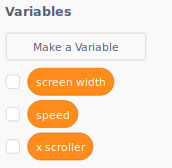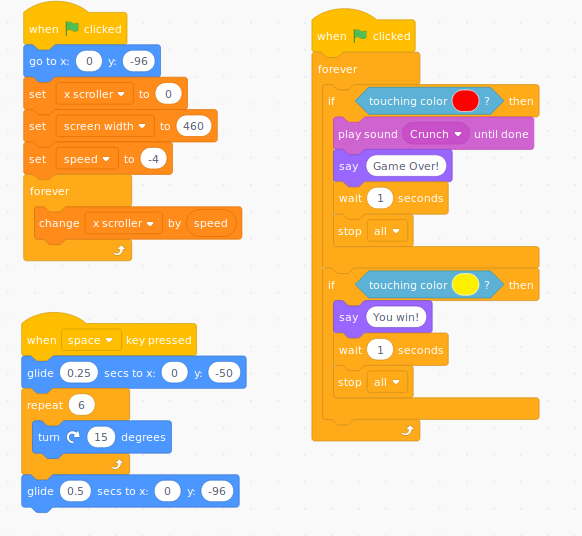Monday 17 June 2019
Fold and Cut Challenge
Did you know that it has been mathematically proven that any shape with straight sides can be cut with one cut, if the paper is pre-folded in the appropriate way?
Tuesday 11 June 2019
Wednesday 22 May 2019
Watering Plants With Microwaved Water - step one
What do you think of this?
To be continued... Look for another post.
Wednesday 8 May 2019
Geometry Dash Instructions
These are some on-line instructions, but I found them hard to follow.
I would recommend the YouTube videos by GriffPatch about how to make scrolling games in Scratch:
Here are basic instructions I created. The final project can be found here:
- Basic Geometry Dash
Make these sprites:

Create these variables for all sprites:

Add this code for the Player Sprite:

Add this code to the Platform 1:

I would recommend the YouTube videos by GriffPatch about how to make scrolling games in Scratch:
Here are basic instructions I created. The final project can be found here:
- Basic Geometry Dash
Make these sprites:
Create these variables for all sprites:
Add this code for the Player Sprite:
Add this code to the Platform 1:
Add this to Platform 3:
Tuesday 30 April 2019
Monday 8 April 2019
Monday 1 April 2019
Drinking Water Protection
Keeping our drinking water clean is important! Here's a short video that talks about what is being done in Ontario:
Saturday 23 March 2019
Fun With Pascal's Triangle
On the next Caribou Contest, there will be a question about Blaise Pascal, the French mathematician for whom Pascal's Triangle is named. Pascal was not the first to discover the triangle, as it was known in ancient China. Regardless, it is full of lots of interesting patterns!
Monday 4 March 2019
Pi Day 2019
Pi Day is coming up on March 14 (3/14)! Here are some fun videos about Pi:
Raytheon Pi Day Video:
Calculating Pi Using Pies (3 min)
Mile of Pi (6 min)
How Pi was Nearly Changed to 3.2 (5 min)
Pi and Buffon’s Matches (6 min)
Tuesday 19 February 2019
Fluor Engineering Challenge 2019 - Volleyball
Here is an overview video of this year's Fluor Engineering Challenge:
- Volleyball Challenge Overview - video
The specific instructions can be found here:
Wednesday 6 February 2019
Scratch Chaser Game
Choose a new sprite, here it is a balloon. Add these blocks to that new sprite. The other sprite in this program is Cat 2.
Add these blocks to the sprite that can move with arrow keys.
Add a background to the game.
Friday 1 February 2019
Fractal Tree Scratch Project
Fractal Tree Scratch Project
- Choose the Ball
- Make these variables:
- Add the Pen Extension. Find:
then
- Add this code on the ball sprite:
- Run the program:
Monday 21 January 2019
Tuesday 8 January 2019
Bonus Computer Program Challenges
Need an extra challenge when programming in class? Try these!
1) Write a program called "LeapYear" in which the user is asked to enter a value - a year to be tested to see if it is a leap year. Have the program say either, yes, the entered year is a leap year, or no it is not.
Hint: How to Calculate a Leap Year
2) Write a program that asks the user for a number and then outputs all prime numbers less than that number. (Look up "Sieve of Eratosthenes" for help with an algorithm.)
3) Create a program that simulates the rolling of two six-sided dice and calculates the sum of the two face values. Have the user enter how many times the dice will be rolled. Keep track in a List of the total number of times that each possible sum was observed. Specifically, create a List called "Sums" and in position 1, count all the times there is a sum of 1 (this should be zero); in position 2, count all of the times the sum is 2; in position 3, count all of the times the sum is 3, etc. Calculate the probability of getting the sum 12. How does this match with your simulation? What if you repeat the simulation more times? What about the sum of 7?
1) Write a program called "LeapYear" in which the user is asked to enter a value - a year to be tested to see if it is a leap year. Have the program say either, yes, the entered year is a leap year, or no it is not.
Hint: How to Calculate a Leap Year
- Start off using the year you want to calculate.
- See if it is evenly divisible by 4 (a whole number with no remainder). If it is not, like 1997, it is not a leap year. ...
- See if the year is divisible by 100. If a year is divisible by 4, but not 100, like 2012, it is a leap year. ...
- See if the year is divisible by 400. If a year is divisible by 100, but not 400, like 1900, then it is not a leap year. If a year is divisible by both, then it is a leap year. So 2000 was indeed a leap year.
2) Write a program that asks the user for a number and then outputs all prime numbers less than that number. (Look up "Sieve of Eratosthenes" for help with an algorithm.)
3) Create a program that simulates the rolling of two six-sided dice and calculates the sum of the two face values. Have the user enter how many times the dice will be rolled. Keep track in a List of the total number of times that each possible sum was observed. Specifically, create a List called "Sums" and in position 1, count all the times there is a sum of 1 (this should be zero); in position 2, count all of the times the sum is 2; in position 3, count all of the times the sum is 3, etc. Calculate the probability of getting the sum 12. How does this match with your simulation? What if you repeat the simulation more times? What about the sum of 7?
Scratch 3.0 is here!
Scratch 3.0, the latest version of the popular block-based programming language, it now available for all users!
Scratch 3.0 will work on both desktops and tablets alike, and has some exciting new blocks: you can make your characters speak out loud, and there is built in support for Makey Makeys!
Scratch was first developed over a decade ago at MIT, as has continued to be a leading resource for students looking to learn to write their own computer programs.
Scratch 3.0 will work on both desktops and tablets alike, and has some exciting new blocks: you can make your characters speak out loud, and there is built in support for Makey Makeys!
Scratch was first developed over a decade ago at MIT, as has continued to be a leading resource for students looking to learn to write their own computer programs.
Subscribe to:
Posts (Atom)